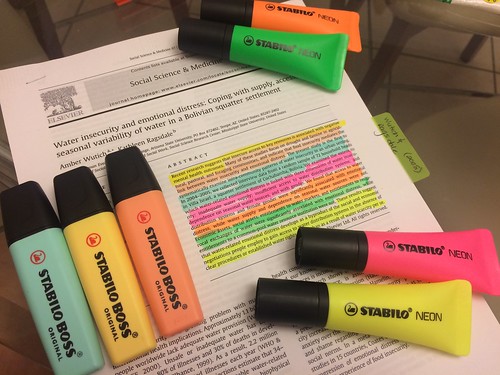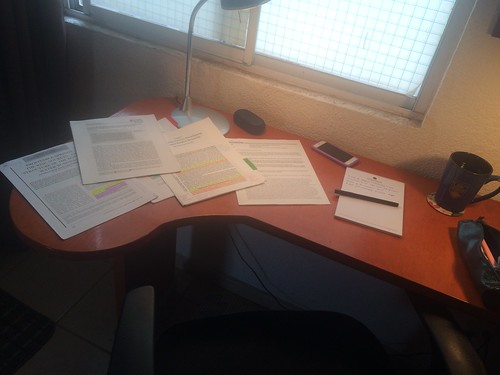Continuing with the series of “challenging questions my students ask”, this is perhaps the one I get from students that I am always wary to respond. “Professor, how do I know which articles I should read in more depth and which ones I should just skim (i.e. do a quick AIC Content Extraction)?”.
Well, now. I wish I had that answer. I learned to triage literally by trial and error. So far, every single book and handout and article I have read on how to do reading and note-taking has said stuff like this “skim titles, first topic sentence, etc.”
I myself offer a few suggestions in the blog post I have stored in my Reading Strategies page, on doing a quick skim (AIC, Abstract, Introduction, Conclusion), to engaging at the meso-level (searching for keywords or key phrases), to reading really fully in-depth (literally going through the entire paper/book).
The problem I find is that we all use heuristics. And each set of heuristics works well (or doesn’t) for specific people. What works for me, may not always function well for others. Developing reading strategies takes time and is something that can only be improved with experience.
You get better at reading (and writing) by reading AND writing.
So my recommendation, always, is “try something, see if it works, if it doesn’t, change it and try again”.
I recently wrote a Twitter thread on triaging and my nested, sequenced, colour-coded highlighting system. I did this thread because I recalled that some people criticise the use of highlighting as a form of engagement. A valid concern is that highlighting may be taken to the extreme, so readers may end up covering All The Text with their highlighter instead of being strategic and just focusing on specific ideas.
One reason why I colour-code highlights and marginalia is to avoid this. I change colors as I go deeper into the argument sequence.
— Dr Raul Pacheco-Vega (@raulpacheco) August 18, 2019
Combining neon + pastel in my nested, 6 colours scheme allows me to see points that are MOST RELEVANT (neon), relevant (pastel) sequenced
— Dr Raul Pacheco-Vega (@raulpacheco) August 18, 2019
Combining neon + pastel in my nested, 6 colours scheme allows me to see points that are MOST RELEVANT (neon), relevant (pastel) sequenced. On to scribbling: I do a combination of summaries of ideas AND I link to other authors, my own research.
My scribbles are a conversation that I am having with MYSELF.
I study the politics of bottled water, I have a chapter in Sultana and Loftus’ forthcoming book on ethics and HRW and BW, I’m working on a book w @christyzen on this, I have a chapter in my own book. Kind of absolutely crucial for me to engage with this paper. On top of it…
— Dr Raul Pacheco-Vega (@raulpacheco) August 18, 2019
… beyond the substance, it’s important for me to cite and highlight the work of emerging, early career scholars. David is a new assistant professor at Missouri and his work is great so it’s important to connect his work to our larger community and scholarly ecosystem. So…
— Dr Raul Pacheco-Vega (@raulpacheco) August 18, 2019
The reasons I provide above are heuristics I use for myself to decide whether a paper should be read in-depth, at the meso-level, or just skimmed. As I note in my tweet, I have reasons to read this paper that go beyond the actual content of the paper.
HOWEVER
Another heuristic I use to decide whether I will read something in more depth is the number, density and relevance of comments I make on a paper. As you will note in the next few tweets, much of what Dr. Switzer is saying is very, very, very closely related to my own research. It would be a disservice not only to his work but to mine if I did not fully engage with his paper. This is not a paper for a quick AIC Content Extraction. This is an article I really need to engage, read, cite.
I have written about the AIC skim read process (Abstract, Introduction, Conclusion) and why, even though it’s great to get the gist of a paper, it’s not a substitute for deep engagement. Experience will give you new and improved reading heuristics. Something I do with my own …
— Dr Raul Pacheco-Vega (@raulpacheco) August 18, 2019
As I have told my students and research assistants: if you are doing a literature review for someone, or your advisor tells you that you should read X, Y or Z stuff, you can (and probably should) ask for pointers as to where to “zoom in” (i.e. read in more depth) and what you should keep “high level” (i.e. skim). I do it with my own students and RAs. Asking for guidance on what to focus on and what to read is ok, by the way.
“Out of these 4 readings I would focus on X and Y for methods, Z for theory and skim W for application of methods to education policy”.
I strongly believe that those who are at earlier stages should always ask for guidance. My students do. My RAs too.
After a while YOU decide
— Dr Raul Pacheco-Vega (@raulpacheco) August 18, 2019
The last point is vital: I tell my students and RAs to make reading part of their daily workflow. My classes are reading-heavy, so if they think they can get away with reading everything the night before they’re going to be exhausted and will probably end up skimming everything.
— Dr Raul Pacheco-Vega (@raulpacheco) August 18, 2019
I think the best way to develop a triaging heuristic is by keeping up with the literature. In my tweets (and everywhere else on my blog) I recommend a daily AICCSED combo. Reading one article a day, writing one CSED row is feasible to me. I know not everyone can make this commitment, but I think RAs and undergraduate and graduate students can, and probably should? But again, to each their own. if you’re going to devote one day to reading, that also works too.
As long as you can find a way to make the time you devote to your reading worthwhile. Which leaves me with the last point of this thread: I sometimes live-tweet my reading, particularly for didactic purposes (for my students). BUT I very, very, very strongly recommend that you avoid all distractions as possible when you read. I do it too (which is why I wake up at Ungodly O’Clock).
As I said a while ago, you Do Not Need To Read All The Things. But you DO need to develop a triaging heuristic that will work for you. The only way to develop this is to practice reading.




One Response
Stay in touch with the conversation, subscribe to the RSS feed for comments on this post.
Continuing the Discussion